
Look at your pond like a garden. Either you or nature nurtures it, and things grow. Fish are fed, plants grow, water provides the medium. You're growing a crop. Harvest? By all means.
You wouldn't plant 52 rows of tomatoes and not harvest any.
Look at your fish the same way...except different. You'll harvest your garden when the vegetables are ripe and the plants have done what they do. In your pond, you pick which fish to take, when you are ready for them, based on what the pond needs.
Each pond has a carrying capacity. Each pond has its own productivity, based on your inputs...or nature's inputs. Part of the fun of pond management is judging what those concepts mean, for your pond.
How do you do that?
Take channel catfish, for example. When most folks stock channel catfish in their pond, they do it primarily for meat for the table. Others stock them as a value-added predator for diversity. Channel catfish are actually predator fish. Most folks don't totally understand that. They are kind of like a teenage boy, though. The teenager heads to the fridge, pulls the door open and looks for his favorite, usually meat. But if there's no meat, he'll eat whatever is available. Channel catfish are the same way. When a channel cat pushes past about 2lh pounds, they'll compete with a one-pound Largemouth bass for food and space.
Stocking rates also determine channel catfish harvest. The more stocked, the more harvested, to keep the standing crop manageable. As another example, say a one-acre pond is stocked with 500 channel catfish fingerlings, say 6-8" long, last spring. They're fed well. By fall, a percentage of those fish, roughly 15%, will already be a pound and a half. Those are plenty big enough to eat. Not many pond owners wish to eat their fish so fast, so they let them grow. By the end of Season Two, the fish range in size from a pound up to three pounds, averaging two pounds. Assuming some attrition, which is normal, a safe guess is this one-acre pond now has about 750 pounds of catfish. Looking back at receipts, this pondmeister has fed about 30 bags of fish food, a good catfish food, to these creatures. If some fish have been weighed to get an average, and the fish food consumption is estimated properly, you can gain an idea of the standing crop. Don't let your standing crop of catfish exceed your water's ability to support them.

what that means. If you can't freshen the water with a well, or pump from an existing lake, or there's minimal flushing from fresh rainwater, don't allow your standing crop of catfish to exceed about 500-600 pounds per acre. If you don't intend to eat catfish, stock fewer.
Another important fact about catfish. Look at them mostly as a put and take fishery. They are cavity spawners. If they don't have a place to hide and lay eggs, they won't successfully reproduce. What you stock, minus natural attrition, is what you have. If you want more, stock them as you harvest. I discourage allowing catfish to spawn in small ponds. Control their numbers. Besides, they don't cost much to stock.
How to create a harvest plan for a predator/prey pond such as bass and bluegills? With this type of fishery, the fish will tell you. Sure, you can feed the bluegills and push them to grow larger and reproduce more. Sure, you can eat some of those bluegills you grow. Release the biggest bluegills—eat the next smaller sizes. Preserve the best-of-the-best to dominate the nests to force younger bluegills to grow even larger. How many can you eat? If you are feeding, you are producing a larger crop. Feed more them, and be sure they are recruiting- having more young to fill the slots as you harvest some fish. A general rule? You can harvest 40-70 pounds of bluegills per acre, maybe more if your pond is highly productive for that species.
What about bass? Since they are likely the top predator fish, catch some, weigh and measure them. Based on your overall goals for that fishery, harvest particular sizes of fish. Careful, though. Catch and release for the first three years. After that, you'll see particular sizes of bass begin to level off their growth rates. Typically, that's bass smaller than 15-inches. When bass start to show themselves levelling off and beginning to decline in weight a little bit, that's a sign it's time to harvest some fish. Think "slot" limit harvest for bass.
What about walleye? Those are also put and take fish, parallel to catfish, except they're total predators. Treat them like you'd treat bass. Their weights compared to length help decide what to harvest.
Here's your bottom line. Your pond needs harvesting. You choose what sizes of what species to harvest. Understanding the dynamics of that fishery helps you make wise choices as which fish to take and which to release.
That's a big part of the joy and fun of having a pond with a healthy fishery.
Reprinted with permission from Pond Boss Magazine



